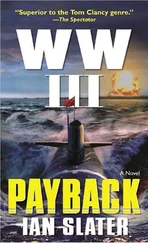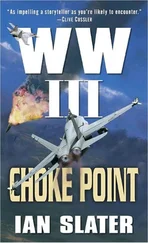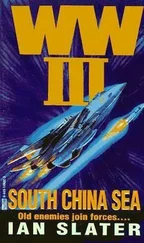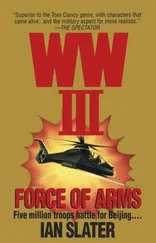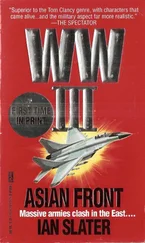Early Fall — Dusk
“Sure beats binoculars,” the sergeant opined softly, one hand deftly slipping another stick of odorless gum into his mouth, the other holding a four-inch-square monitor. “Clear as crystal.”
Lieutenant Sammy Ramon nodded as he too watched the monitor his sergeant was holding. The live video feed of the lake’s research facility a quarter of a mile below was coming in from the twelve-man team’s tiny eight-inch MAV recon plane. The micro air vehicle, developed by DARPA, the U.S. Defense Department’s Advanced Research and Projects Agency, was made up of collapsible transparent wings and tail and equipped with a Viccol video camera and laser range finder. To get a closer look at the monitor, the lieutenant, using his left hand to remove his “Fritz” Kevlar helmet, his right to slide his M-16 forward to his side, momentarily wiped the beaded perspiration from his drab olive-green face paint, the latter indistinguishable from the camouflage paint of his collapsible Paratrooper mountain bike nearby. For security reasons, the other eleven men in the lieutenant’s commando squad hadn’t been given the precise in-country coordinates of the enemy naval base below, yet each man, looking down from his hide toward the lake, knew the exact layout of the base, everything from the small data hut on the lake’s sandy shoreline to the bigger and more vital research barge offshore.
Though the MAV couldn’t be detected by enemy radar because of its stealth-fiber, sharp-edged construction, affording it an extraordinarily small radar signature, it nevertheless gave the lieutenant a start when, for a second, it passed as a black dot across the lemon wafer of the moon that was already visible in the dusk. But any fright the momentary silhouette might have given him was ameliorated by the fact that apart from the lone civilian security guard, which the MAV’s infrared vision had detected, there seemed to be no other visible defenses. Once again, the lieutenant had occasion to remind himself of what a fellow soldier, retired U.S. Army General Douglas Freeman, had once said on a CNN interview after 9/11, that base security, indeed security anywhere, is more often a state of mind than a reality, more an assumption than a fact.
As the tiny plane circled the enemy base again, Ramon switched to watching the target through his own video-mounted M-16, which gave him a head-on view of it, a lone barge in the fading light. The ninety-foot-long, thirty-foot-wide research barge hadn’t changed location, remaining anchored more than a hundred yards offshore from the bungalow-sized hut onshore. Intel had told the lieutenant that while this bungalow would have to be neutralized, it was the barge that contained the data they were after and which would, therefore, be the commando team’s primary target. Neither the lieutenant, nor any of the eleven men under his command, had been told what the data were specifically, only that they would be on a disk and how the disk would be labeled. But they had been told that this data was so vital it could irrevocably tip the balance of power in favor of the United States, not only in its ongoing war against terror but also in the face of China’s massive buildup of high-tech weaponry following the Chinese leaders’ jaw-dropping surprise at witnessing America’s delivery of shock and awe in the two Gulf wars.
Lieutenant Ramon’s first job was to get his team into the enemy base before he could neutralize the main hut onshore and loot the barge computer’s hard drive, as well as the disk which scientists back home could use to reverse-engineer the weapon. Intel had told Ramon the data had originally been spawned by a Russian prototype of the revolutionary technology.
Ramon had told his assault team that they were to approach the naval base with as casual an air as possible — just another case of a friendly visit from U.S. troops coming back from maneuvers during the day — and not to give a damn about the security cameras around the research station’s perimeter. Ramon would give a friendly howdy-do to the security guard who was looking bored out of his mind from walking up and down along the quarter-mile chain-link storm fence that enclosed the shore hut and the fifty-foot-long jetty where a small rigid inflatable boat, obviously used for transport to and from the barge, was bobbing up and down in a small chop.
Each of the twelve commandos extracted his collapsible khaki DARPA-designed Paratrooper mountain bike from its canvas shoulder bag, mounted up, and pedaled off.
Some were soon freewheeling and braking, but quietly, as they headed down the blacktop road toward the fence’s gate. Sammy Ramon spoke to each man personally as he had before the mission, warning them that if he heard so much as a squeak or squeal coming from these special post-Afghanistan-designed bikes, he’d see to it that the man responsible would be put on a charge. “Absolutely nothing,” he’d intoned, “is to go wrong.” Pushing for perfection, the lieutenant had had them endlessly practicing extraction, snap assembly, and disassembly. To qualify, each of the eleven commandos had to be equally proficient in handling his MOLLE, as the DARPA-designed state-of-the-art Modular Lightweight Load-Carrying Equipment pack was known, and which was equipped with an ergonomically designed plastic frame capable of hauling a central rucksack plus eighteen additional pouches of DARPA-designed “goodies,” including everything from extra ammunition for the video-mounted, red-dot-aiming M-16s to their GPS-updated inertial navigation system and DARPA-designed MAV. Every man had to extract his bike from his shoulder pack and assemble its two folding halves in less than thirty seconds, his MOLLE in under five minutes.
Using bikes instead of noisy Humvees, Ramon had explained to his team, would enhance their “just passing by” explanation to the security guard. After all, what could be more natural than a group of the U.S. Tenth Mountain Division’s bicycle unit out practicing with their bikes and just waving “hi” to the locals in the spirit of mutual cooperation? Ramon and his team knew that what they were about to do, if all went well, was strictly against all international law, but in the war between America and terrorists, rules were frequently thrown out the window. The enemy, Intel had assured him, wouldn’t be expecting an attack. But Sammy Ramon’s hard experience told him that HUMINT, human intelligence, and SIGINT, signal intelligence, could be dead wrong. Look at Tony Blair and George Bush’s search for WMDs. Intel had also told Ramon that there’d been reports of long copper-mesh curtains having been erected inside the onshore data-receiving hut and on board the offshore barge, this being done, Intel reports had said, in order to block any extraneous radio signals that might scramble any of the critical electronic communication traffic between the hut and offshore barge while they were calibrating their equipment. All he needed, the lieutenant told his sergeant, was for the guard, a dark, swarthy man with a submachine gun slung about his shoulder, to stand still for a couple of seconds.
“You got the envelope?” asked the sergeant.
The lieutenant patted his battle dress shirt pocket. “I’m set.”
As dusk faded, day easing into night, and the breeze that carried the faint smell of algae from the lake became cooler, Ramon watched the moon’s pale light sharply silhouetting the onshore hut and the offshore barge. Now they were ten yards from the chain-link gate and the big sign that warned in six languages “KEEP OUT.”
“This is it,” Ramon said softly to his sergeant as he stopped his column of eleven men, who, as they’d rehearsed it, were doing their damnedest to look tired and disinterested, their expressions suggesting they wanted to get back to their camp rather than waste time while the lieutenant started yakking with the locals.
Читать дальше

